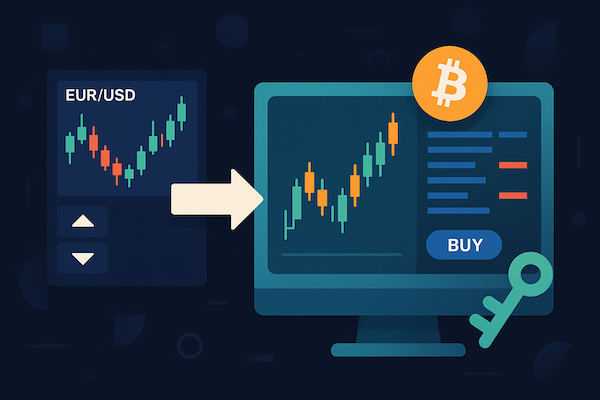For most of the 2000s, a trader’s workstation told a neatly partitioned story: MetaTrader or a bank terminal for currencies on the left, a browser tab with a crypto exchange (if it existed at all) on the right. Fast-forward to 2024, and that neat divide is disappearing.
The same charting panel that once pip-tracked EUR/USD now streams perpetual‐swap funding rates, and a single API key can pull quotes from both Tier-1 forex liquidity pools and deep crypto order books. Today, trading crypto with Forex brokers isn’t a fringe experiment but a core feature of many multi-asset platforms, uniting retail traders and institutional desks under a single execution layer. How did we get here? Below, we map the evolutionary path of hardware, software, and market structure that carried trading platforms from single-asset forex dashboards to fully integrated crypto gateways.
The Forex Foundation (1998–2010)

Desktop Domination
The modern retail trading frenzy sparked with MetaTrader 4’s release in 2005. Its selling points, custom indicators, low system requirements, and the now-legendary Expert Advisor framework defined what “a forex platform” looked like. Simultaneously, institutional players leaned on Reuters Dealing, EBS, and Currenex for interbank execution. Each of these platforms had three common attributes that still matter today:
- Real-time price aggregation (multiple liquidity providers, one quote ladder).
- Order‐driven matching engines that cleared millions of trades per second.
- Extensibility via APIs, chiefly the FIX protocol, which invited early quants to plug in algorithms.
The FIX DNA
Financial Information eXchange (FIX) 4.2 may feel stodgy compared with JSON over WebSockets, yet it set a precedent for open, low-latency data highways. Any tech stack that could translate an order ticket into a FIX message could talk to any bank on the planet. That standardization turned “connectivity” from a competitive moat into table stakes, a cultural shift that would later benefit crypto.
Catalysts That Redefined Expectations
Algorithmic arms race. By 2011, almost 80% of spot-FX trades in London were algorithmically executed. Retail traders took notice; brokers started shipping VPS hosting and closer data centers. The performance mindset latency, measured in milliseconds, became part of platform marketing.
Mobile first, cloud later. MT4’s iPhone app (2005) changed bedtime routines for an entire generation of retail traders. The feature list was light, but the psychological impact was huge: the idea that markets are continuous and should be managed anywhere. This expectation pressured platform providers to decouple core processing (back end) from presentation layers (mobile, web, desktop). When crypto eventually entered the scene, the architecture to deliver 24/7 quotes was already half-built.
Bitcoin Arrives and Breaks the Mold (2011–2014)
Bitcoin’s birth exposed a class of assets with no reference rate, no prime broker, and wild weekend gaps. Early exchanges like Mt. Gox improvised with PHP scripts and MySQL tables that would buckle under modest FX-desk traffic. Yet demand snowballed, and the shortcomings surfaced lessons:
- Custody risk is existential. Hacks forced crypto venues to redesign wallet infrastructure, hot, warm, and cold storage layers that traditional forex custodians never had to consider.
- 24/7 risk management. In crypto, risk engines could not rest at 5 p.m. New York closed. Auto-deleveraging and insurance funds emerged as unique circuit breakers.
- User-driven API culture. Public REST endpoints became a default feature; many crypto venues opened them before they had polished GUIs. This API-first ethos would influence how later multi-asset platforms approached design.
The Convergence Phase (2015–2019)
Brokers dip their toes. CFDs on Bitcoin appeared on mainstream forex brokers around 2016. These were synthetic; you never owned coins, but they proved the client’s appetite. Liquidity bridges soon let brokers hedge CFD exposure on real crypto exchanges, effectively knitting order books together.
Stablecoins as lubricants. Tether, USDC, and later BUSD acted as dollar proxies inside crypto rails. For multi-asset brokers, stablecoins solved two headaches:
- Funding friction. Traders could move capital 24/7, skipping the two-day SWIFT cycle.
- Collateral management. A stablecoin margin account sits comfortably next to an FX cash balance in risk calculations.
UI/UX cross-pollination. Crypto exchanges borrowed the candlestick chart, depth graph, and hotkey ladder from FX. Conversely, forex terminals started adding dark mode, on-chart order editing, and social leaderboards, ideas popularized by crypto apps.
APIs and the Liquidity Mesh (2020–2022)
One endpoint, many markets. Unified APIs like CCXT (crypto) and XChange (multi-asset Java) emerged, making brokerage-agnostic connectivity a weekend project rather than a quarter-long integration. For higher-frequency desks, consolidated WebSocket feeds provided millisecond snapshots across forex, crypto, and even commodity pairs. The term “liquidity mesh” entered the industry vocabulary with multiple venues, one smart router.
Smart order routing (SOR). By looking at both FX ECNs and crypto CLOBs, SOR engines executed the best price discovery across asset classes. Example: a EUR/USDT swap routed partially through a stablecoin pool while simultaneously offsetting EUR/USD in an ECN. The trader sees “one click”; under the hood, two liquidity universes handshake.
Non-Custodial, On-Chain Possibilities (2021–Present)

Bridging Centralized and Decentralized Finance
MetaMask’s signature pop-up next to an institutional FIX gateway is no longer science fiction. Hybrid aggregators such as Copper’s ClearLoop and Fireblocks’ Network allow platforms to route orders to centralized exchanges while settling assets on-chain later, slashing hot-wallet exposure.
DeFi Order Flow
Protocols like 0x RFQ and 1inch Fusion opened APIs where large takers can get firm quotes without revealing intent, echoing dark-pool logic from equities. Multi-asset platforms embed these routes alongside CEX order books, giving traders optionality between custody models and fee structures.
Compliance Catch-Ip
Travel Rule solutions (e.g., TRISA, Notabene) mean that address screening and counterparty verification can be automated directly inside a trading platform. Crypto’s anti-money-laundering toolkit is slowly approaching the maturity level of established FX compliance suites.
User Experience: From Terminals to Super Apps
Contextual dashboards. The modern multi-asset dashboard detects whether a user is scalping USD/JPY or yield-farming USDC/ETH and surfaces tools accordingly. Variable tick sizes, margin requirements, and tax reporting modes change in real time. Personalization engines originally built to suggest forex EAs now recommend staking pools or funding-rate arbitrage.
Social layers. Copy-trading and leaderboards originated in retail FX (think Zulutrade), but crypto’s culture of public PnL accelerated adoption. Platforms now gamify both arenas: monthly pips for EUR/GBP and realized PnL for ETH/BTC count toward the same badge system.
Multichain wallets inside the platform. An integrated wallet can spin up sub-accounts across multiple chains, sign transactions, and reconcile ledger entries to the same PnL statement that houses forex rollovers. That level of frictionless asset management would have sounded outrageous to a 2010 FX dealer.
New Security and Regulatory Paradigms
Segregated multi-asset custody. Regulators now require that client crypto deposits be held in segregated addresses mirroring FX’s “seg client funds” model. The tech stack responded with multi-party computation (MPC) custody that supports both USDC on Ethereum and fiat held at a correspondent bank visible in the same audit trail.
MiCA and beyond. The EU’s Markets in Crypto-Assets (MiCA) regulation borrows best practices from MiFID II order‐to-trade ratios, pre-trade transparency, and grafts them onto token markets. Platforms that already complied with MiFID found the leap smaller, reinforcing the notion that a single, cross-asset compliance engine is cheaper than two siloed teams.
Insurance and SAFU funds. Crypto exchanges introduced “Secure Asset Funds for Users.” Now we see multi-asset brokers extending similar insurance pools to cover extreme FX events (think Swiss‐franc shock) and crypto black-swan hacks under one umbrella, funded by a slice of taker fees from all markets.
The Road Ahead: Tokenized FX, AI-Driven Execution, and Composable Platforms
Tokenized fiat and real-time settlement. Major banks are piloting tokenized deposits or “regulated stablecoins.” Imagine executing EUR/USD, settling in seconds on a private chain, and instantly deploying that EUR token as collateral for a DeFi loan, all from the same platform. That vision pushes latency not only in market data but also in settlement finality.
AI as co-pilot. Execution algorithms are evolving from static TWAP/VWAP to adaptive agents that weigh crypto volatility surfaces against macro data. A cross-asset AI could pivot from a mean-reversion bot on GBP/USD to a breakout strategy on SOL/USDT based on regime shifts without redeployment.
Composable micro-frontends. The next-gen platform may look less like a monolithic terminal and more like a swappable Lego board: plug-in chart modules, third-party lending widgets, NFT price trackers. Web components and open-source design kits ensure that whether you trade yen or yield farms, your tools speak the same design language.
Conclusion: A New Default Setting
The line between “forex broker” and “crypto exchange” has blurred into irrelevance. Today’s trader expects:
- 24/7 uptime and mobile symmetry.
- Direct API access with sub-100 ms latency.
- Custody optionality: centralized, decentralized, or hybrid.
- One margin pool that tolerates pips, satoshis, and gas fees alike.
Those expectations co-evolved with the platforms themselves. From MetaTrader’s single-asset roots to smart-routed, on-chain-settled super apps, each technological leap solved a problem in one market and then crossed into the other. The result is a trading ecosystem where asset class no longer dictates software choice, and innovation in one corner quickly becomes baseline everywhere else.
For tech-savvy traders, this evolution is empowering. For platform engineers and regulators, it’s a relentless arms race. One thing is clear: whatever ticker flashes on your screen tomorrow, whether a traditional currency pair or a tokenized stake in a metaverse, it will probably trade on the same interface you’re using today, just with a new plug-in installed.


